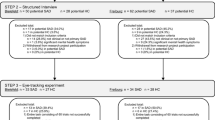Abstract
Recent research has indicated that anxious adult and child patients and high trait-anxious adults selectively shift attention toward threatening stimuli. The present study extends this research and investigates the content-specificity of the effects in clinically anxious and mixed anxious–depressed children and adolescents. Twenty four generally anxious patients, aged 9 to 18, 19 mixed anxious–depressed patients, and 24 normal controls were comparable with respect to age, sex, verbal IQ, and vocabulary level. The participants carried out an attentional deployment task in which probe detection latency data were used to determine the distribution of visual attention for threat-related and depression-related material. The results showed that clinically anxious children, relative to controls, selectively allocated processing resources toward threat stimuli. However, mixed anxious–depressed children, relative to controls, did not show any attentional bias towards either threat- or depression-related stimuli. Preliminary data on age and gender differences are also presented. The results of this study are discussed in the light of previous research.
Similar content being viewed by others
REFERENCES
American Psychiatric Association. (1994). Diagnostic and statistical manual of mental disorders (4th ed.). Washington, DC: Author.
Beck, A. T., & Clark, D. A. (1988). Anxiety and depression: An information processing perspective. Anxiety Research, 1, 520–526.
Beck, A. T., Emery, G., & Greenberg, L. (1985). Anxiety disorders and phobias: A cognitive perspective. New York: Basic Books.
Beck, A. T., Rush, A. J., Shaw, B. F., & Emery, G. (1979). Cognitive therapy of depression. New York: Guilford Press.
Birleson, P. (1981). The validity of depressive disorder in childhood and the development of a self-rating scale: A research report. Journal of Child Psychology and Psychiatry, 22, 73–88.
Carroll, J. B., Davies, P., & Richman, B. (1971). Word frequency book. New York: American Heritage.
Dunn, L. M., Whetton, C., & Pintillie, D. (1981). British picture vocabulary scale. Berkshire, England: NFER-Nelson.
Jolly, J. B. (1993). A multi-method test of the cognitive content-specificity hypothesis in young adolescents. Journal of Anxiety Disorders, 7, 223–233.
Kaslow, N. J., Stark, K. D., Printz, B., Livingston, R., & Tsai, S. L. (1992). Cognitive triad inventory for children: Development and relation to depression and anxiety. Journal of Clinical Child Psychology, 21, 339–347.
Laurent, J., & Stark, K. D. (1993). Testing the cognitive content-specificity hypothesis with anxious and depressed youngsters. Journal of Abnormal Psychology, 102, 226–237.
Leitenberg, H., Yost, L. W., & Carroll-Wilson, M. (1986). Negative cognitive errors in children: Questionnaire development, normative data, and comparison between children with and without self-reported symptoms of depression, low self-esteem, and evaluation anxiety. Journal of Consulting and Clinical Psychology, 54, 528–536.
MacLeod, C., & Mathews, A. (1988). Anxiety and the allocation of attention to threat. Quarterly Journal of Experimental Psychology, 40, 653–670.
MacLeod, C., Mathews, A., & Tata, P. (1986). Attentional bias in emotional disorders. Journal of Abnormal Psychology, 95, 15–20.
Martin, M., Williams, R. M., & Clark, D. M. (1991). Does anxiety lead to selective processing of threat-related information? Behaviour Research and Therapy, 29, 147–160.
Mogg, K., Bradley, B. P., Williams, R., & Mathews, A. (1993). Subliminal processing of emotional information in anxiety and depression. Journal of Abnormal Psychology, 102, 304–311.
Mogg, K., Mathews, A., Bird, C., & MacGregor-Morris, R. (1990). Effects of stress and anxiety on the processing of threat stimuli. Journal of Personality and Social Psychology, 59, 1230–1237.
Mogg, K., Mathews, A., & Eysenck, M. W. (1992). Attentional bias to threat in clinical anxiety states. Cognition & Emotion, 6, 149–159.
Neshat-Doost, H. T., Moradi, A. R., Taghavi, S. M. R., Yule, W., & Dalgleish, T. (in press). The development of a corpus of emotional words produced by children and adolescents. Personality and Individual Differences.
Neshat-Doost, H. T., Taghavi, S. M. R., Moradi, A. R., Yule, W., & Dalgleish, T. (1998). Memory for emotional material in clinically depressed children and adolescents. Journal of Abnormal Psychology, 107, 642–650.
Reynolds, C. R., & Richmond, B. O. (1978). What I think and feel: A revised measure of children's manifest anxiety. Journal of Abnormal Child Psychology, 6, 271–280.
Rust, J., Golombok, S., & Trickey, G. (1993). Basic reading comprehension. London, England: The Psychological Corporation, Harcourt Brace Jovanovich.
Stark, K. D., Humphrey, L. L., Laurent, J., Livingston, R., & Christopher, J. (1993). Cognitive, behavioral, and family factors in the differentiation of depressive and anxiety disorders during childhood. Journal of Consulting and Clinical Psychology, 6, 878–886.
Vasey, M. W., Daleiden, E. L., Williams, L. L., & Brown, L. (1995). Biased attention in childhood anxiety disorders: A preliminary study. Journal of Abnormal Child Psychology, 23, 267–279.
Vasey, M. W., Elhag, N., & Daleiden, E. L. (1996). Anxiety and the processing of emotionally-threatening stimuli: Distinctive patterns of selective attention among high-and low-anxious children. Child Development, 67, 1173–1185.
Williams, J. M. G., Watts, P. N., MacLeod, C., & Mathews, A. (1988). Cognitive psychology and emotional disorders. Chichester, England: Wiley.
Williams, J. M. G., Watts, P. N., MacLeod, C., & Mathews, A. (1997). Cognitive psychology and emotional disorders (2nd ed.). Chichester, England: Wiley.
Author information
Authors and Affiliations
Corresponding author
Rights and permissions
About this article
Cite this article
Taghavi, M.R., Neshat-Doost, H.T., Moradi, A.R. et al. Biases in Visual Attention in Children and Adolescents With Clinical Anxiety and Mixed Anxiety-Depression. J Abnorm Child Psychol 27, 215–223 (1999). https://doi.org/10.1023/A:1021952407074
Issue Date:
DOI: https://doi.org/10.1023/A:1021952407074




